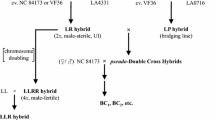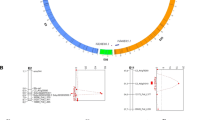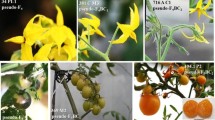Summary
While Lycopersicon esculentum and Solanum lycopersicoides have been successfully hybridized, attempts at further direct gene introgression have been unsuccessful due to the presence of incompatibility barriers. A systematic study of the initial hybridization and subsequent backcrosses has identified multiple barriers to introgression. These barriers are expressed as pollen tube inhibition in the upper style and lower pistil, and failures in syngamy, zygote development, and sporogenesis. Upper style cross-incompatibility barriers were successfully avoided by bud pollinations using a stigma complementation procedure to allow pollen germination on otherwise unreceptive stigmas. The inhibition of pollen tube growth was observed in the lower pistil. A combination of environmental, plant, and genetic manipulations facilitated consistent pollen tube growth to the ovule micropyles in all crosses attempted. Failures at syngamy and early zygote formation proved to be the most difficult barriers to overcome — these were particularly severe in crosses to F1 hybrid plants. Progeny were obtained in all crossing combinations attempted except in the initial hybridization with S. lycopersicoides as the pistillate parent. Although the strong pre-zygotic barriers were overcome in this cross, further progress was restricted by post-zygotic failures. The capability to overcome pre-zygotic barriers and to excise and culture very young embryos has allowed plantlet recovery from male sterile F1 plants. Partially pollen-fertile F1 plants were recovered when relatively large F1 populations were generated from different S. lycopersicoides accessions. In general, barriers to introgression diminished with increased backcrossing, though exceptions were noted. Progeny from the second backcross to L. esculentum possessed adequate fertility to set self-seed under field conditions. Although all backcross progeny were developed from only a few F1 individuals, considerable genetic variability was recovered for fruit and vegetative characteristics. Potentially useful levels of disease resistance, particularly to Botrytis cinerea, were also recovered.
Similar content being viewed by others
References
Alexander LJ (1956) Embryo culture of tomato interspecific hybrids. Phytopathology 46:6 (abstr)
Alexander MP (1969) Differential straining of aborted and nonaborted pollen. Stain Technol 44:117–122
Anderson E (1953) Introgressive hybridization. Biol Rev 28:280
Anderson E, Hubricht L (1938) Hybridization in Tradescantia. III. The evidence for introgressive hybridization. Am J Bot 25:396–408
Choudhury B (1959) Development of seed and its parts. Hybrid seed of Lycopersicon esculentum and Lycopersicon peruvianum. Indian J Hortic 16:23–30
DeVerna JW, Chetelat RT, Rick CM, Stevens MA (1987a) Introgression of Solanum lycopersicoides germplasm. In: Nevins DJ, Jones RA (eds) Tomato biotechnology. Liss, New York, pp 27–36
DeVerna JW, Chetelat RT, Rick CM (1987b) Cytogenetic, electrophoretic, and morphological analysis of progeny of sesquidiploid Lycopersicon esculentum — Solanum lycopersicoides hybrids × L. pennellii. Biol Zentralbl 106:417–428
Gradziel TM, Robinson RW (1986) Overcoming pollination barriers in the Solanaceae. Proceedings of the XXII International Horticultural Congress, p 249 (abstr)
Hadley HH, Openshaw SI (1980) Interspecific and intergeneric hybridization. In: Fehr WR, Hadley HH (eds) Hybridization of crop plants. American Society of Agronomy/Crop Science Society of America, Madison, Wis, pp 133–160
Handley LW, Nickels RL, Cameron MW, Moore PP, Sink KC (1986) Somatic hybrid plants between Lycopersicon esculentum and Solanum lycopersicoides. Theor Appl Genet 71:691–697
Hermsen JGT (1979) Factors controlling interspecific crossability and their bearing on the strategy for breaking barriers to intercrossing of tuber bearing Solanum species. In: Zeven AC, Harten AM van (eds) Proceedings of the Conference on Broadening the Genetic Base of Crops, Centre for Agricultural Publishing and Documentation, Wageningen, pp 311–318
Herner RC, Kamps T (1983) Chilling injury tolerance of wild tomato species. Proceedings of the 4th Tomato Quality Workshop on Vegetable Crops, Res Rep VEC-83-1
Hogenboom NG (1972a) Breaking breeding barriers in Lycopersicon. IV. Breakdown of unilateral incompatibility between L. peruvianum (L.) Mill, and L. esculentum. Euphytica 21:397–404
Hogenboom NG (1972b) Breaking breeding barriers in Lycopersicon. V. The inheritance of the unilateral incompatibility between L. peruvianum (L.) Mill, and L. esculentum Mill, and the genetics of its breakdown. Euphytica 21:405–414
Hogenboom NG (1975) Incompatibility and incongruity: two different mechanisms for the nonfunctioning of intimate partner relationships. Proc R Soc London Ser B 188:361–375
Kho YO, Baer J (1968) Observing pollen tubes by means of fluorescence. Euphytica 17:298–302
Khush GS, Rick CM (1963) Meiosis in hybrids between Lycopersicon esculentum and Solanum pennellii. Genetica (the Hague) 33:167–183
Marks GE (1965) Cytogenetic studies in tuberous Solanum species. III. Species relationships in some South and Central American species. New Phytol 64:293–296
Marubashi WT, Nakajima T (1981) Pollen tube behavior in the ovary of Nicotiana tabacum L. Jpn J Breed 31:133–140
McGuire D, Rick CM (1954) Self-incompatibility in species of Lycopersicon sect Eriopersicon and hybrids with Lycopersicon esculentum. Hilgardia 23:101–124
McLean JG, Stevenson FJ (1952) Methods of obtaining seeds on Russett Burbank and similar flowering varieties of potato. Am Potato J 29:206–211
Menzel MY (1962) Pachytene chromosomes of the intergeneric hybrid Lycopersicon esculentum — Solanum lycopersicoides and its parents. Am J Bot 49:605–615
Munger HM, Lane D (1983) An improved method of BA application for the promotion of fruit set in muskmelon. Cucurbit Genet Coop Rep 6:51
Neal CA, Topoleski LD (1983) Effects of the basal medium on growth of immature tomato embryos in vitro. J Am Soc Hortic Sci 108:434–438
Neal CA, Topoleski LD (1985) Hormonal regulation of growth and development of tomato embryos in vitro. J Am Soc Hortic Sci 110:869–873
Nettancourt D de (1977) Incompatibility in angiosperms. (Monographs on theoretical and applied genetics, vol 3) Springer, Berlin Heidelberg New York
Phills BR, Provvidenti R, Robinson RW (1977) Reaction of Solanum lycopersicoides to vital diseases of the tomato. Tomato Genet Coop Rep 27:18
Raghavan V, Torrey JG (1963) Growth and morphogenesis of globular and older embryos of Capsella in culture. Am J Bot 50:540–551
Rick CM (1951) Hybrids between Lycopersicon esculentum Mill, and Solanum lycopersicoides Dun. Proc Natl Acad Sci USA 37:741–744
Rick CM (1979) Potential improvement of tomato by controlled introgression of genes from wild species. In: Zeven AC, Harten AM van (eds) Proceedings of the Conference on Broadening the Genetic Base of Crops. Centre for Agricultural Publishing and Documentation, Wageningen, pp 167–173
Rick CM, Hunt D (1953) The use of growth-promoting substances as an aid in tomato breeding. Tomato Genet Coop Rep 3:22–23
Rick CM, Smith PG (1953) Novel variation in tomato species hybrids. Am Nat 87:359–373
Rick CM, De Verna JW, Chetelat RT, Stevens MA (1986) Meiosis in sesquidiploid hybrids of Lycopersicon esculentum and Solanum lycopersicoides. Proc Natl Acad Sci USA 83:3580–3583
Robinson RW, Phills BR (1979) Overcoming sterility in an intergeneric hybrid. Tomato Genet Coop Rep 29:33
Visser T, Marucci MC (1983) Pollen and pollination experiments. IX. The pioneer pollen effect in apple and pear related to the interval between pollinations and the temperature. Euphytica 32:703–709
Wann EV, Johnson KW (1962) Intergeneric hybridization involving species of Solanum and Lycopersicon. Bot Gaz (Chicago) 124:451–455
Author information
Authors and Affiliations
Rights and permissions
About this article
Cite this article
Gradziel, T.M., Robinson, R.W. Solanum lycopersicoides gene introgression to tomato, Lycopersicon esculentum, through the systematic avoidance and suppression of breeding barriers. Sexual Plant Reprod 2, 43–52 (1989). https://doi.org/10.1007/BF00190118
Issue Date:
DOI: https://doi.org/10.1007/BF00190118




